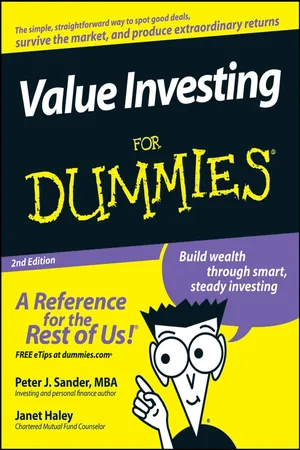
- English
- ePUB (mobile friendly)
- Available on iOS & Android
Value Investing For Dummies
About this book
Want to follow in Warren Buffett's investing footprints? Value Investing For Dummies, 2nd Edition, explains what value investing is and how to incorporate it into your overall investment strategy. It presents a simple, straightforward way to apply proven investment principles, spot good deals, and produce extraordinary returns.
This plain-English guide reveals the secrets of how to value stocks, decide when the price is right, and make your move. You'll find out why a good deal is a good deal, no matter what the bulls and bears say, get tips in investing during jittery times, and understand how to detect hidden agendas in financial reports. And, you'll uncover the keys to identifying the truly good businesses with enduring and growing value that continually outperform both their competition and the market as a whole. Discover how to:
- Understand financial investments
- View markets like a value investor
- Assess a company's value
- Make use of value investing resources
- Incorporate fundamentals and intangibles
- Make the most of funds, REITs, and ETFs
- Develop your own investing style
- Figure out what a financial statement is really telling you
- Decipher earnings and cash-flow statements
- Detect irrational exuberance in company publications
- Make a value judgment and decide when to buy
Complete with helpful lists of the telltale signs of value and "unvalue, " as well as the habits of highly successful value investors, Value Investing For Dummies, 2 nd Edition, could be the smartest investment you'll ever make!
Frequently asked questions
- Essential is ideal for learners and professionals who enjoy exploring a wide range of subjects. Access the Essential Library with 800,000+ trusted titles and best-sellers across business, personal growth, and the humanities. Includes unlimited reading time and Standard Read Aloud voice.
- Complete: Perfect for advanced learners and researchers needing full, unrestricted access. Unlock 1.4M+ books across hundreds of subjects, including academic and specialized titles. The Complete Plan also includes advanced features like Premium Read Aloud and Research Assistant.
Please note we cannot support devices running on iOS 13 and Android 7 or earlier. Learn more about using the app.
Information
Part I
The What and Why of Value Investing

Chapter 1
An Investor’s Guide to Value Investing
In This Chapter




Definitions? No Two Are Alike
What Is Value Investing?
Buying a business
Making a conscious appraisal
Table of contents
- Title
- Contents
- Introduction
- Part I : The What and Why of Value Investing
- Part II : Fundamentals for Fundamentalists
- Part III : So You Wanna Buy a Business?
- Part IV : Becoming a Value Investor
- Part V : The Part of Tens
- : Further Reading